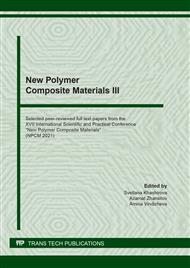[1]
E. Gotlib, P.T.N. Ha, T.L.A. Nguyen, A. Sokolova, E. Yamaleeva, I. Musin, Agricultural by-products as advanced raw materials for obtaining modifiers and fillers for epoxy materials, Key Engineering Materials. 822 (2019) 343-349.
DOI: 10.4028/www.scientific.net/kem.822.343
Google Scholar
[2]
V.A. Tyulnin, V.R. Tkach, V.I. Eirich, Wollastonite - a unique mineral raw material for multipurpose purposes, Ore and Metals, Moscow, (2003).
Google Scholar
[3]
M.S Nizami, Studies on the synthesis of wollastonite from rice husk ash and limestone", Institute of Chemistry, University of the Punjab, Lahore Pakistan. (1993).
Google Scholar
[4]
L.A. Zemnukhova, G.A. Phedoritshcheva, А.G. Egorov, V.I. Sergienko, Investigation of the conditions of obtaining, composition, extraneous matters and properties of amorphous silicon dioxide from the rice by-products, Journal of Applied Chemistry. 2 (2005) 324-328.
Google Scholar
[5]
E.M. Gotlib, I. D. Tverdov, T.N.F. Phuong, E.S. Yamaleeva, Optimization of the temperature for obtaining synthetic wollastonite based on rice husks, Butlerov Communications. 63 (8) (2020) 18-23.
DOI: 10.37952/roi-jbc-01/20-63-8-18
Google Scholar
[6]
M.I. Koryakina, Laboratory workshop on technical analysis and control of production of paints and varnishes and coatings, Chemistry, Moscow, (1989).
Google Scholar
[7]
I.S. Deev, E.V. Kurshev, S.L. Lansky, G.F. Zhelezina, The influence of long-term climatic aging on the surface microstructure of epoxy organoplastics and the nature of its destruction under bending conditions, Problems of materials science. 87 (3) (2016) 104-114.
Google Scholar
[8]
E.N. Cherezova, E.S. Il'lcheva E.S., Yu.A. Aver'Yanova, Influence of the structure of organic peroxides on the efficiency of modification of SKI-3 rubber with dicarboxylic acid anhydrides in solution, Russian Journal of Applied Chemistry. 84 (11) (2011) 2018-2020.
DOI: 10.1134/s1070427211110358
Google Scholar
[9]
R. Magbudov, Climatic resistance of polymer composite materials based on epoxy binders, Regional architecture and construction. 1 (2015) 34-42.
Google Scholar
[10]
V.P. Selyaev, T.A. Nizina, Yu.A. Lankina, Assessment of changes in the decorative properties of protective coatings under the influence of UV irradiation, Bulletin of Mordovian University. 4 (2008) 128-133.
Google Scholar
[11]
T.A. Nizina, V.P. Selyaev, D.R. Nizin, D.A. Artamonov, Climatic resistance of polymer composite materials based on epoxy binders, Regional architecture and construction. 1 (2015) 34-42.
Google Scholar
[12]
V.N. Kirillov, V.A. Efimov, T.E. Matveenkova, T.G. Korenkova, Influence of the Sequential Impact of Climatic and Operational Factors on the Properties of Fiberglass Plastics, Aviation Industry. 1 (2004) 45-48.
Google Scholar
[13]
V.N. Kirillov, N.S. Kavun, V.P. Rakitina et al., Investigation of the effect of heat and humidity on the properties of epoxy glass fiber laminates, Plastics. 9 (2008) 14-17.
Google Scholar


